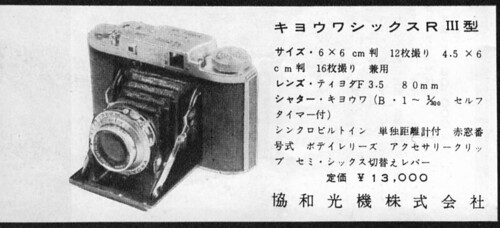Kyowa Six
The Kyowa Six (キョーワ・シックス) is a Japanese folding camera with uncoupled rangefinder, taking 6×6 and 4.5×6 exposures. It was made by Kyōwa Kōki in 1954–5.[1] The only known model is called Kyowa Six RIII; it came after the Flora Six II and III by the same company, and the "R" in the name certainly stands for Rangefinder.
Contents
Description
Main body
The Kyowa Six RIII is a horizontal folder with three-part folding struts inspired from the Ikonta. These are eng The main body casting is apparently the same as on the Flora Six made by the same company.
The viewfinder and uncoupled rangefinder are contained in the top housing. They share a common eyepiece offset to the left — as seen by the photographer. The viewfinder window has a frame at the front, attached by two screws, and the rectangular second-image window is on the right. The rangefinder is controlled by a distance wheel actuated by the right thumb. The selected distance appears under a translucent window above the wheel, to the right of the accessory shoe. The shutter release is at its usual location on the right.
There is a sliding button on the back of the top housing, with 4.5 and 6 indications, switching a mask inside the viewfinder and another inside the exposure chamber.[2] This allows to change the picture format in mid-roll. However the user can switch only when the film roll has reached certain numbers: 1, 4, 7, 10 to switch from 6×6 to 4.5×6 and 1, 5, 9, 13 for the reverse.[3] This device was the object of the Japanese utility model (実用新案) no.19012.[2]
The advance knob is at the left end of the top plate, it has three concentric rings and an arrow to indicate the winding direction. There is a small film flange at the opposite end, with two concentric rings. The back is hinged to the right and contains two red windows to control the film advance. They are protected by sliding covers, marked 4.5X6 and 6X6, copied on the red window covers of the Olympus Chrome Six.
The name Kyowa Six is engraved on the top housing, together with the body serial number and the mention MODEL RIII. The folding struts have a KYOWA logo, which is also embossed in the leather of the front door, and the name KYOWA–SIX is embossed at the bottom of the back.
Lens and shutter
The lens is a Chiyoda 80mm f/3.5, made by a company called Chiyoda Kōgaku Kōgyō[2] (which is not to be confused with Chiyoda Kōgaku Seikō, predecessor of Minolta). The shutter is a five-blade Kyowa or Synchro-Kyowa (B, 1–300, self-timer). The name KYOWA or SYNCHRO–KYOWA is engraved at the bottom of the rim.[4] Both shutter models are synchronized via a PC socket, but the Synchro-Kyowa has an additional switch for M or X flash synchronization. It is said that this was the first Japanese shutter incorporating an M/X synch selector;[3]it was the object of the Japanese utility model no.405668.[2]
Commercial life and surviving examples
The Kyowa Six RIII was featured in Japanese magazines dated August to November 1954.[3] The August 1954 advertisement in Camera Mainichi gives the price of ¥13,000 and mentions Kyōwa Kōki as the maker and Hioki Shōkai as the authorized dealer.[2] The Kyowa Six was advertised until August 1955.[3] It is still mentioned in the November 1955 special issue of Photo Art on folding cameras, reproduced below, at an unchanged price.[5] The camera was probably succeeded by the Orion Six,[6] which has the same body and similar features.

|
| Kyowa Six RIII in the November 1955 special issue of Photo Art. (Image rights) |
Very few examples of the Kyowa Six have been observed so far. The only confirmed body number is 59388.[4] Known lens numbers are 532426 and 5322304.[4] It seems that "532" is a prefix, and the actual number comes afterwards.
Notes
- ↑ Date: advertisements and articles listed in Kokusan kamera no rekishi, p.351.
- ↑ 2.0 2.1 2.2 2.3 2.4 Advertisement in Camera Mainichi August 1954, reproduced in Kokusan kamera no rekishi, p.134.
- ↑ 3.0 3.1 3.2 3.3 Kokusan kamera no rekishi, p.351.
- ↑ 4.0 4.1 4.2 Examples observed in online auctions.
- ↑ Column in Photo Art no.89, November 1955, p.67.
- ↑ The Orion Six is listed as the successor of the Kyowa Six in this page by Terasaki Haruhisa.
Bibliography
- Asahi Camera (アサヒカメラ) editorial staff. Shōwa 10–40nen kōkoku ni miru kokusan kamera no rekishi (昭和10–40年広告にみる国産カメラの歴史, Japanese camera history as seen in advertisements, 1935–1965). Tokyo: Asahi Shinbunsha, 1994. ISBN 4-02-330312-7. Item 488.
- Photo Art rinji zōkan: Saishin supuringu kamera zensho (フォトアート臨時増刊・最新スプリングカメラ全書, Photo Art special issue: All the latest folding cameras). November 1955, no.89 of the magazine. "Supuringu kamera mihonshi" (スプリングカメラ見本市, Folding camera trade fair). Pp.55–69.
The Kyowa Six is not listed in Sugiyama.
